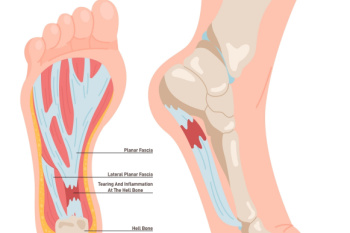
A broken toe occurs when one of the bones in the toe fractures due to trauma or excessive pressure. This condition can result from stubbing the toe against a hard object, dropping something heavy on the foot, or repetitive stress from activities like running. Symptoms include swelling, bruising, pain, and difficulty walking. Immediate attention is important to prevent complications, such as improper healing or joint stiffness. Relief begins with rest and elevating the foot to reduce swelling. In some cases, taping the broken toe to an adjacent one provides stability. If the pain is severe or the toe appears misshapen, it is suggested that you promptly consult a podiatrist who can offer appropriate treatment solutions.
A broken toe can be very painful and lead to complications if not properly fixed. If you have any concerns about your feet, contact Dr. Odin De Los Reyes from Connecticut. Our doctor will treat your foot and ankle needs.
What to Know About a Broken Toe
Although most people try to avoid foot trauma such as banging, stubbing, or dropping heavy objects on their feet, the unfortunate fact is that it is a common occurrence. Given the fact that toes are positioned in front of the feet, they typically sustain the brunt of such trauma. When trauma occurs to a toe, the result can be a painful break (fracture).
Symptoms of a Broken Toe
- Throbbing pain
- Swelling
- Bruising on the skin and toenail
- The inability to move the toe
- Toe appears crooked or disfigured
- Tingling or numbness in the toe
Generally, it is best to stay off of the injured toe with the affected foot elevated.
Severe toe fractures may be treated with a splint, cast, and in some cases, minor surgery. Due to its position and the pressure it endures with daily activity, future complications can occur if the big toe is not properly treated.
If you have any questions please feel free to contact our offices located in Southbury and Farmington, CT . We offer the newest diagnostic and treatment technologies for all your foot and ankle needs.

Chronic plantar fasciitis occurs when the plantar fascia, the thick band of tissue along the bottom of the foot, remains inflamed for longer than six months. It typically causes persistent heel pain, especially with the first steps in the morning or after long periods of rest. Diagnosis involves a physical examination where a podiatrist checks for tenderness along the heel and arch, as well as assessing range of motion and foot structure. Imaging tests like ultrasounds or MRI scans may be used to rule out other conditions. Risk factors include having flat feet or high arches, obesity, occupations that require prolonged standing, and repetitive impact activities like running. Plantar fasciitis can be painful and may cause difficulty in completing daily activities. If you have this condition, it is suggested that you are under the care of a podiatrist who can offer effective treatment solutions.
Plantar fasciitis can be very painful and inconvenient. If you are experiencing heel pain or symptoms of plantar fasciitis, contact Dr. Odin De Los Reyes from Connecticut. Our doctor can provide the care you need to keep you pain-free and on your feet.
What Is Plantar Fasciitis?
Plantar fasciitis is the inflammation of the thick band of tissue that runs along the bottom of your foot, known as the plantar fascia, and causes mild to severe heel pain.
What Causes Plantar Fasciitis?
- Excessive running
- Non-supportive shoes
- Overpronation
- Repeated stretching and tearing of the plantar fascia
How Can It Be Treated?
- Conservative measures – anti-inflammatories, ice packs, stretching exercises, physical therapy, orthotic devices
- Shockwave therapy – sound waves are sent to the affected area to facilitate healing and are usually used for chronic cases of plantar fasciitis
- Surgery – usually only used as a last resort when all else fails. The plantar fascia can be surgically detached from the heel
While very treatable, plantar fasciitis is definitely not something that should be ignored. Especially in severe cases, speaking to your doctor right away is highly recommended to avoid complications and severe heel pain. Your podiatrist can work with you to provide the appropriate treatment options tailored to your condition.
If you have any questions please feel free to contact our offices located in Southbury and Farmington, CT . We offer the newest diagnostic and treatment technologies for all your foot and ankle needs.

Choosing the right walking shoes is essential for maintaining foot health and overall comfort during daily activities. A good walking shoe should have a low heel to promote stability and reduce strain on the feet. It is important to ensure there is enough wiggle room in the toe box so that toes can move freely without feeling cramped. Taking a test walk around the store can help determine if the shoes provide adequate support, cushioning, and fit. It is also helpful to shop later in the day when feet are slightly swollen, as this reflects their true size during regular use. If you enjoy walking, it is important to wear the right type of shoes, or foot pain may develop. If this has happened to you, it is suggested that you contact a podiatrist who can treat various foot conditions.
Getting the right shoe size is an important part of proper foot health. Seek the assistance of Dr. Odin De Los Reyes from Connecticut. Our doctor will provide the care you need to keep you pain-free and on your feet.
Getting the Right Shoe Size
There are many people who wear shoes that are the incorrect size, negatively affecting their feet and posture. Selecting the right shoes is not a difficult process, so long as you keep several things in mind when it comes to choosing the right pair.
- When visiting the shoe store, use the tools available to measure your foot.
- Be sure there is ‘wiggle room’. There should be about an inch between your toes and the tip of your shoes.
- Do not always assume you are the same size, as manufacturers run differently.
- Purchase shoes later in the day, as your feet swell as the day progresses.
- If a shoe is not comfortable, it is not suitable. Most shoes can’t be ‘broken in’, and comfort should be the ultimate goal when it comes to choosing the right pair of shoes
As our feet hold our body weight and keep us moving, it is important to treat them right. Picking the right pair of shoes can provide your feet comfort and mobility without pain.
If you have any questions, please feel free to contact our offices located in Southbury and Farmington, CT . We offer the newest diagnostic and treatment technologies for all your foot care needs.

